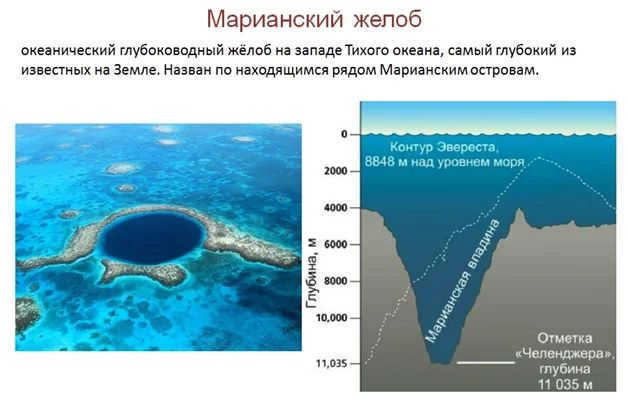Before, it was believed that the Earth’s crust was immobile and inflexible. However, the revolutionary concept of plate tectonics has completely transformed our understanding of how the Earth’s crust is formed. It reveals the continuous motion of the planet’s surface, which is evidenced by seismic activities, volcanic eruptions, the creation of mountains, and the formation of volcanic basins. What is our current knowledge on this subject?
Discover “Hitech” within
What is the composition of the Earth’s surface?
Beneath the Earth’s mantle lies the geosphere, the central and deepest part of our planet. It is believed to be primarily made up of an iron-nickel alloy, along with other siderophilic elements. This layer extends approximately 2,900 kilometers below the surface.
The Earth’s mantle, which is the thickest layer of the planet, reaches a depth of 2,890 km. The pressure in the lower mantle is estimated to be around 140 GPa (1.4-10^6 atm).
Rich in iron and magnesium compared to the crust above it, the mantle is composed of silicate rocks. The high temperatures in this layer cause the silicate material to become pliable, allowing for the convection of matter from the mantle to the surface through faults in tectonic plates.
The depth of the crust can range from 5 to 70 kilometers beneath the surface. The oceanic crust, which lies beneath the ocean basins and is the thinnest part (5-10 km), is made up of dense rock containing iron and magnesium silicate, specifically basalt.
In this material, we will specifically examine the upper section of the Earth’s structure known as the lithospheric plates.
How are lithospheric plates organized?
The organization of lithospheric plates involves two distinct types of the Earth’s crust: continental crust and oceanic crust. Some plates consist entirely of oceanic crust, while others have a combination of continental crust surrounded by oceanic crust.
The thickness of the oceanic lithosphere, also known as lithospheric thickness, can range from 2-3 km near the rift zones of the oceans to 80-90 km near the continental margins. In contrast, the continental lithosphere can be as thick as 200-220 km.
Lithospheric plates are in a constant state of change, with the ability to split apart through rifting or merge together through collision. Additionally, these plates can submerge into the Earth’s mantle, descending to the depths of the outer core.
However, the classification of the Earth’s crust into plates is not straightforward, and as our understanding of geology grows, new plates are identified while some plate boundaries are found to be non-existent. As a result, these outlines also change over time. This is particularly true for smaller plates, where geologists have proposed multiple conflicting reconstructions.
In our current era, the horizontal movement of lithospheric plates ranges from 1 to 6 cm per year (with plate sliding rates varying from 2 to 12 cm per year). Specifically, the rate of plate sliding along the northern section of the Mid-Atlantic Ridge is 2.3 cm per year, while in the southern section it is 4 cm per year.
The East Pacific Ridge near Easter Island holds the record for the fastest plate movement, clocking in at a remarkable speed of 18 centimeters per year. On the other end of the spectrum, the Gulf of Aden and the Red Sea experience the slowest plate movement, with a sluggish rate of 1-1.5 centimeters per year.
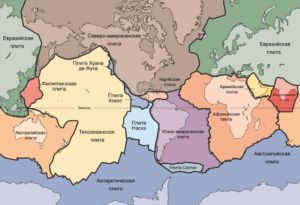
Different Types of Plate Collisions:
The collision occurs when an oceanic plate and a continental plate come together. The oceanic plate, which has a thinner crust, slides beneath the thicker continental plate. Some examples of this type of collision include the Nazca Plate colliding with the South American plate and the Cocos Plate colliding with the North American plate.
In another type of collision, one plate moves beneath another plate that contains an island group. Examples of this type of collision include the North American plate colliding with the Okhotsk plate, the Amur plate, the Philippine plate, and the Indo-Australian plate. Similarly, the South American plate collides with the Caribbean plate.
There is also a type of collision where neither plate yields to the other, resulting in the formation of mountains. One example of this type of collision is the Indian plate colliding with the Eurasian plate.
Based on the latest scientific understanding of plate tectonics, the Earth’s crust is composed of lithospheric plates that are relatively intact and constantly moving in relation to one another.
Simultaneously, new oceanic crust is being formed in areas of expansion such as mid-ocean ridges and continental rifts through a process known as seafloor spreading, while older crust is being consumed in subduction zones.
Thermal convection within the mantle is a highly effective mechanism for transferring heat energy from the Earth’s core. This convection creates large-scale convective cells that can span thousands of kilometers. The areas where hot, less dense mantle material rises correspond to the spreading zones of the ocean floor.
The downward streams of colder and denser material from the mantle pull in plates of the lithosphere in subduction areas. The movement of the plates is caused by the sticky adhesion of the upper mantle material, which is undergoing convection, to the uneven base of the lithosphere.
The present-day movements of lithospheric plates are detected through various methods, with space geodesy techniques being the most common. Modern GPS receivers have the ability to measure plate movements with an accuracy of a fraction of a millimeter per year.
The effects of lithospheric plate movement can also be seen in seismic displacements – disturbances in the continuity of rock caused by earthquakes, which are a result of the sudden release of stress in the Earth’s crust.
A well-known instance of a seismic disruption can be seen in a fence located on a farm in California, close to San Francisco. This fence has been split into two sections and displaced by several meters along the San Andreas Fault.
What does the future hold for the field of tectonics?
Despite its seemingly simple and elegant nature, the concept of lithospheric plate tectonics is constantly evolving as new data is gathered.
One of the current topics in modern tectonics and geodynamics is the exploration of the causes behind intraplate and hotspot magmatism. These phenomena lead to the formation of chains of oceanic islands like Hawaii, supervolcanoes like Yellowstone, and large magmatic provinces such as the Siberian traps and the Deccan Plateau traps in India.
One of the prevailing theories that seeks to explain the origins of intraplate magmatism centers around the concept of mantle plumes. These plumes are essentially columns of hot mantle material that rise up from the core-mantle boundary, providing an excess of heat compared to the average mantle temperature. This surplus heat is what triggers the melting of vast quantities of magma.
When these melts reach the surface, whether it be on land or on the ocean floor, they give rise to large eruptive regions that are primarily composed of basaltic lavas.
In the event that a plume encounters the oceanic crust as it ascends, it has the ability to burn through it, resulting in the formation of volcanic islands – submarine volcanoes that protrude above the ocean’s surface – or extensive oceanic basalt plateaus, such as the Ontong Java Plateau in the Pacific Ocean.
For more information, please click here
The outer part of the lithosphere is known as the Earth’s crust. It is the firm outer covering of the planet, composed of rocks, minerals, and biogenic sediments. The majority of the Earth’s crust is submerged beneath the waters of the World Ocean (hydrosphere), while a smaller portion actively interacts with the Earth’s atmospheric shell (atmosphere). The average thickness of this solid outer shell is 35-40 km, with its thinnest point found beneath the oceans and its thickest point beneath the continents. To put it in perspective, the thickness of the Earth’s crust can be compared to that of an apple peel on a planetary scale.
Within the Earth’s crust, the temperature remains constant up to a depth of 20-30 m, after which it begins to rise by approximately 30C for every 100 meters.
Composition of the Earth’s Crust
The Earth’s crust is comprised of distinct layers of rocks which vary in their source, density, and thickness.
The sedimentary and granite layers have been extensively researched due to their visibility on the Earth’s surface. However, the basalt layer remains an enigma for scientists, as even a 10-kilometer ultra-deep well on the Kola Peninsula was unable to penetrate its depths.
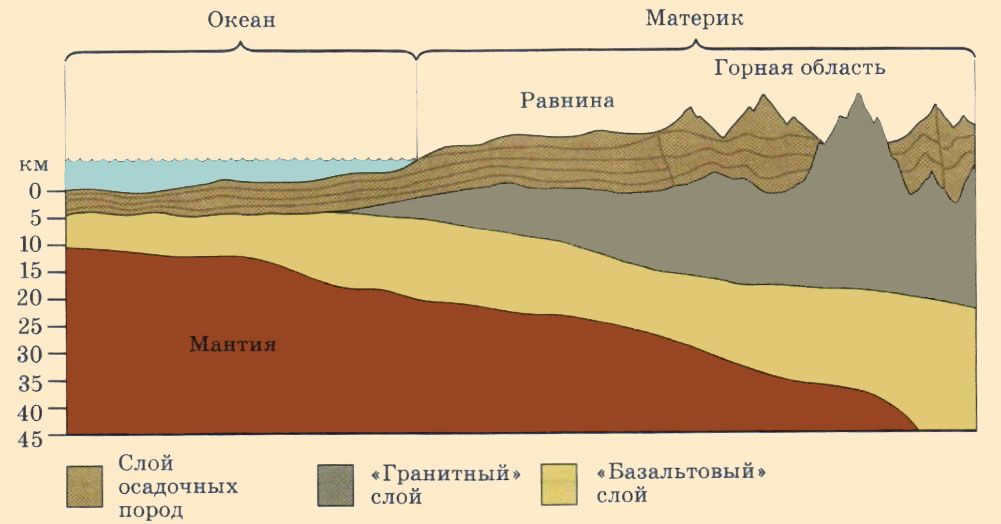
Seismolocation has made it possible to determine the composition of the Earth’s crust. The density and elasticity of rocks influence the speed and direction of seismic waves that are generated during an earthquake. By analyzing these seismic waves, scientists have been able to gain insights into the different layers that make up the Earth’s crust.
Classification of the Earth’s crust
The Earth’s crust can be classified into two main types: continental and oceanic. The oceanic crust constitutes the majority, accounting for 56% of the Earth’s total crust area, while the continental crust makes up the remaining 44%.
These two types of crust differ in terms of thickness and the number of rock layers they contain.
One notable characteristic is that the continental crust can reach a maximum thickness of 80 km, as evidenced by its presence beneath the Himalayas, the highest mountain range on Earth.
Composition of the Earth’s Crust: Chemical Elements
The Earth’s crust is composed of various chemical elements found in the Periodic Table created by D.I. Mendeleev. However, it is interesting to note that a mere 8 chemical elements make up a staggering 99% of the Earth’s crust.
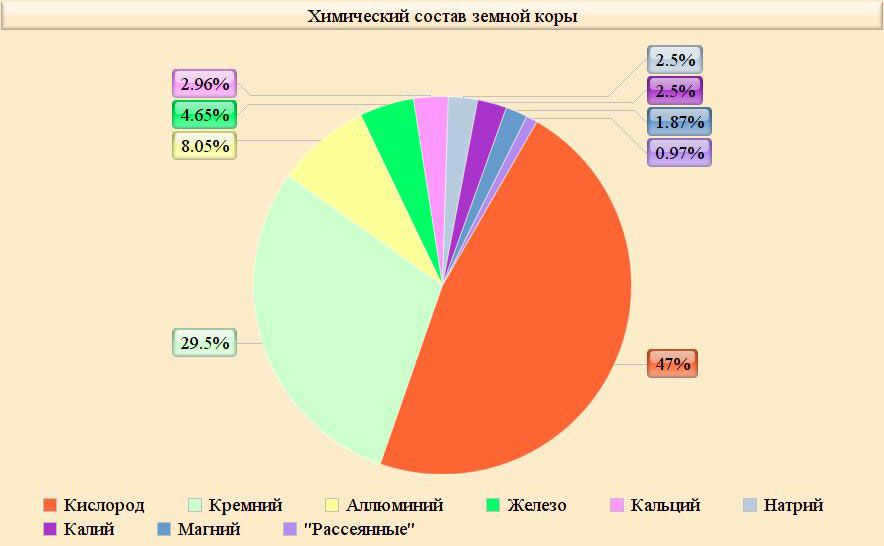

- The elements present in the Earth’s crust include oxygen, silicon, aluminum, iron, calcium, sodium, potassium, and magnesium.
The remaining 1% of the chemical elements are referred to as the diffuse.
Chemical elements combine with one another to create the compounds that compose minerals. There are currently 6000 known minerals, with only 100-150 of them being considered common, while the remainder are exceedingly rare.
How the Earth’s crust undergoes changes
Alterations in the Earth’s crust occur due to the impact of both external and internal forces:
- Internal forces represent the energy from within the Earth’s core. Over time, this energy accumulates and forcefully emerges, causing seismic activities and volcanic eruptions.
- External forces encompass the energy from the Sun, which gets converted into wind and water energy. This energy manifests through temperature variations and serves as the foundation for the existence of living organisms. Under the influence of external forces, mountains erode, solid rocks disintegrate into sand, flowing waters erode deep riverbeds, and valleys are formed. Human activities also contribute as external forces.
Changes in the Earth’s crust occur at a very gradual pace, making them imperceptible to human observation within their lifetime.
The Importance of Studying the Earth’s Crust
Geology is the primary scientific field that examines the Earth’s crust in its entirety. It focuses on analyzing the composition, structure, movement, and history of the Earth’s crust, as well as the minerals it contains.
Various minerals, such as coal, oil, and metal ores, play a crucial role in industrial development. They serve as fuel and raw materials for the production of essential materials and products. Discovering new mineral deposits is vital for assessing current reserves and predicting their utilization.
By studying the rocks that form the layers of the Earth’s crust, scientists can gain insights into the planet’s historical past. Organic rocks, in particular, provide clues about the ancient organisms that once inhabited our planet.
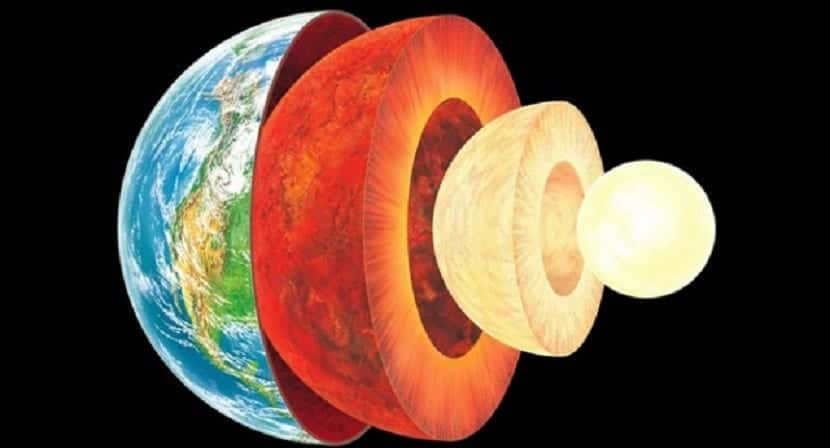

Now that we have knowledge of the Earth’s atmospheric layers, it’s time to delve into the layers that compose our planet. Throughout history, humans have always been curious about what lies beneath the Earth’s crust. Questions about the origin of minerals, the variety of rocks, and the different layers that exist on our planet have sparked our curiosity.
The branch of geology that focuses on studying the structure and various layers of the Earth is known as Internal Geodynamics. Our planet is made up of a combination of solids, liquids, and gases, which are distributed among its different layers.
The Earth’s Layers: A Unique Description
In order to provide a comprehensive description of the Earth’s layers, it is necessary to make two important distinctions. Firstly, we must consider the chemical composition of each layer. This leads us to identify the Earth’s crust, mantle, and core. These layers can be referred to as a “Static model.” Secondly, we need to take into account the physical properties and mechanical behavior of these layers. This gives us the Lithosphere, asthenosphere, mesosphere, and endosphere. These layers can be seen as a “Mechanical Behavior model.”
However, how can we determine the boundaries of each layer? Scientists have developed various techniques to identify the composition of materials and to distinguish between layers based on their irregularities. These imperfections represent areas within the Earth’s interior where there is a significant change in the type of material, whether it be a shift in chemical composition or a transition from a solid to a liquid state.
To begin with, let’s classify the Earth’s layers according to a chemical model, which means we will refer to them as the crust, mantle, and core.
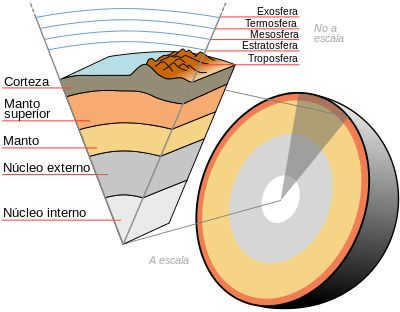

The Earth’s layers can be understood from a chemical perspective.
Exploring the Earth’s crust
The Earth’s crust is the outermost layer of the planet. It has an average density of 3 g/cm3 and makes up only 1.6% of the total land area. The crust is further divided into two distinct regions: Continental crust and oceanic crust.
The Earth’s continental crust
The Earth’s continental crust is characterized by its thickness and complex structure. It is also the oldest type of crust and covers approximately 40% of the Earth’s surface. The continental crust is primarily composed of sedimentary rocks, including clays, sandstones, and limestones. Additionally, it contains silica-rich plutonic igneous rocks, similar to granite. Interestingly, the rocks of the continental crust preserve a record of many geological events that have occurred throughout the Earth’s history. This is due to the numerous physical and chemical changes that these rocks have undergone over time. For instance, mountain ranges often contain ancient rocks that date back as far as 3.5 billion years.
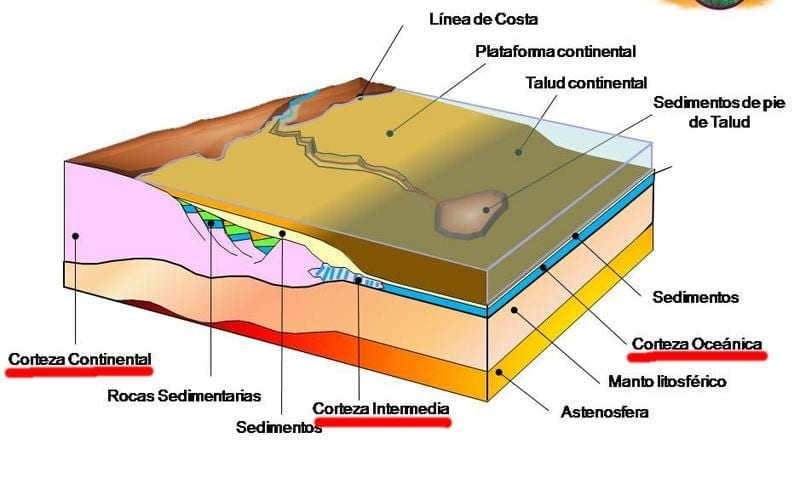

The Earth’s Crust
On the flip side, we also have the oceanic crust. It is thinner and has a simpler composition. It is made up of two layers: a thin layer of sediments and a layer of basalt, which is a type of volcanic rock. The oceanic crust is relatively young compared to the continental crust as the basalt continues to form and break down. Therefore, the rocks in the oceanic crust are less than 200 million years old.
At the boundary between the Earth’s crust and the mantle, there is a discontinuity known as the Mohorovicic (Moho) discontinuity. This separation is approximately 50 kilometers deep.
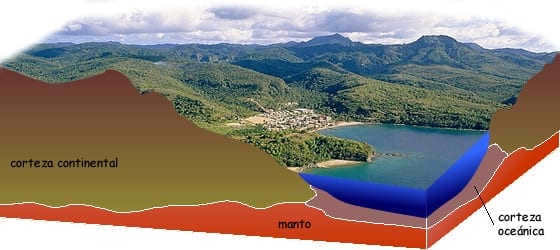
Oceanic crust is not as thick as continental crust.
The mantle of the Earth
The Earth’s mantle is a section of the Earth that stretches from the bottom of the crust to the outer core. It begins immediately after the Moho rupture and is considered the largest layer on the planet. It makes up 82% of the Earth’s total volume and 69% of its total mass. The mantle can be further divided into two layers, which are separated by The secondary Repetti rupture. This rupture occurs at a depth of about 800 km and marks the boundary between the upper mantle and the lower mantle.
Located in the upper mantle is a layer known as “Layer D.” This particular layer is situated approximately 200 km below the Earth’s surface and exhibits the unique characteristic of having 5% to 10% of its composition in a partially molten state. As a result, heat emanates from the Earth’s core and travels upwards through the mantle. The elevated temperatures within the mantle cause the rocks to become hotter, which can occasionally lead to the upward movement of these rocks and the subsequent formation of volcanoes. These specific volcanic formations are commonly referred to as “hot spots.”
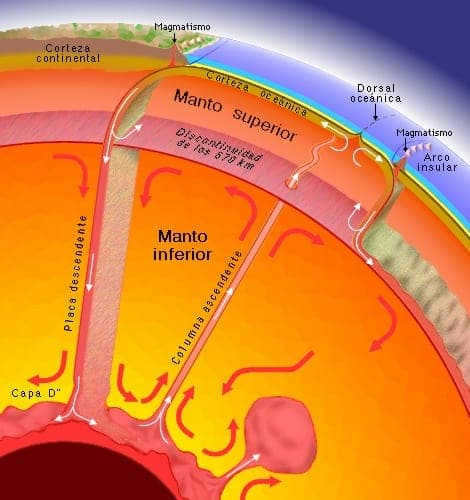

One can determine the composition of the mantle through various examinations:
- Meteorites come in two types: the first is made up of peridotites and iron.
- Rocks found on the Earth’s surface from the mantle are pushed outward due to tectonic movements.
- Volcanic chimneys: these are circular holes of significant depth through which magma ascended and created them. They can stretch up to 200 kilometers.
- Examinations that observe the shortening of seismic waves as they pass through the mantle reveal the presence of a phase transition. This phase transition refers to a change in the mineral structure.
Located at the boundary between the Earth’s mantle and core, the Gutenberg discontinuity is a significant rupture that exists approximately 2,900 kilometers beneath the Earth’s surface.
The Earth’s core:
The Earth’s core, which encompasses the region from the Gutenberg rupture to the very center of the Earth, is the innermost part of our planet. With a radius measuring 3,486 km, it occupies approximately 16% of the Earth’s total volume. Due to its composition of exceptionally dense materials, the Earth’s core accounts for 31% of the Earth’s total mass.
The Earth’s magnetic field is generated by the convection currents in the outer core, which is molten around the solid inner core. In this region, temperatures reach extremely high levels, ranging from 5,000 to 6,000 degrees Celsius, while the pressure is equivalent to one to three million atmospheres.
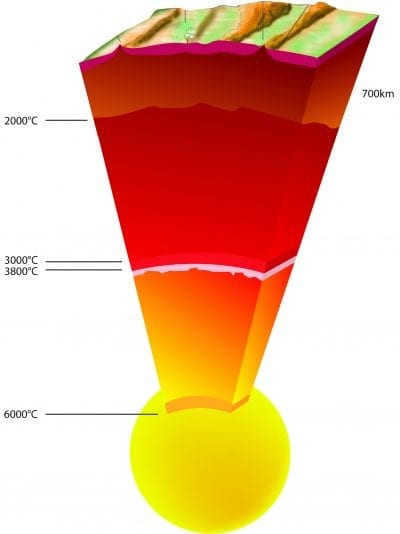
The temperature range at depth
The Earth’s core is divided into an inner and outer core, and the difference is expressed as a the secondary Wichert rupture. The outer core is located at depths ranging from 2,900 km to 5,100 km and is in a molten state. On the other hand, the inner core extends from 5,100 to 6,000 km deep, all the way to the center of the Earth at approximately 6,000 km, and is solid.
The Earth’s core is primarily composed of iron with 5-10% nickel and smaller amounts of sulfur, silicon, and oxygen. There are several tests that help scientists understand the composition of the core:
- One example is the observation of very dense materials, which remain in the Earth’s inner core due to their high density.
- Another test involves studying iron meteorites.
- The presence of iron concentrated inside the Earth’s crust suggests that there is a scarcity of iron on the exterior.
- The Earth’s magnetic field is created by the iron present in the core.
This classification is based on a model that considers the chemical composition of different regions of the Earth and the elements that constitute its layers. We now acknowledge the differentiation of the Earth’s layers in order to model its mechanical behavior, specifically the physical characteristics of its constituent materials.
Divisions of the Earth based on the mechanical model
The mechanical model categorizes the Earth’s layers into: Lithosphere, Asthenosphere, Mesosphere, and Endosphere.
Lithosphere
The lithosphere is a solid layer that is approximately 100 kilometers in thickness and comprises of the crust and the uppermost part of the upper mantle. It is the solid outer layer that encloses the Earth.
Asthenosphere
The asthenosphere is the malleable layer that comprises the majority of the upper mantle. Within this region, convection currents are present, resulting in continuous movement. The asthenosphere plays a crucial role in tectonics. This motion is induced by convection, which occurs due to alterations in material density.
The mesosphere extends from depths ranging from 660 kilometers to 2,900 kilometers. This region is situated within the lower mantle and is also part of the Earth’s outer core. Its boundary is marked by the secondary Wichert rupture.
Endosphere
The endosphere encompasses the innermost core of the Earth, as mentioned previously.
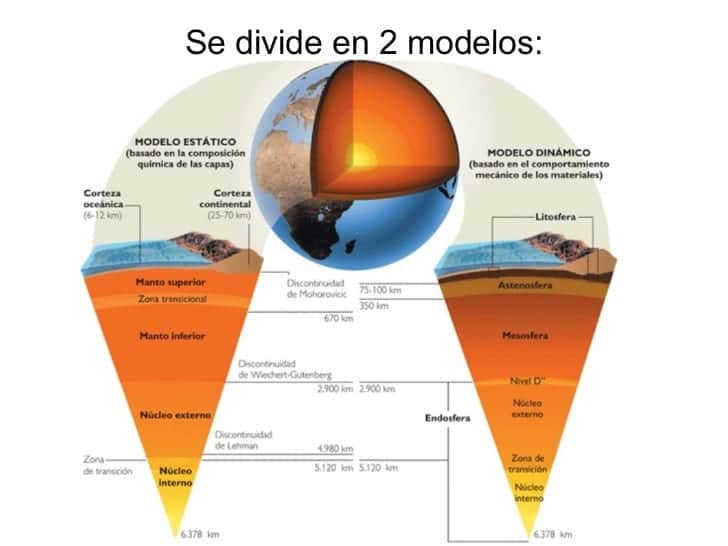
Scientists have conducted various tests and gathered evidence to gain a deeper understanding of the Earth’s interior. Despite our technological advancements, our knowledge about the planet we inhabit is still limited. To put it into perspective, imagine the Earth as an apple. We have only explored its surface to a depth of approximately 12 kilometers, which is equivalent to peeling off the outermost layer of the apple. The core of the apple represents the Earth’s core.
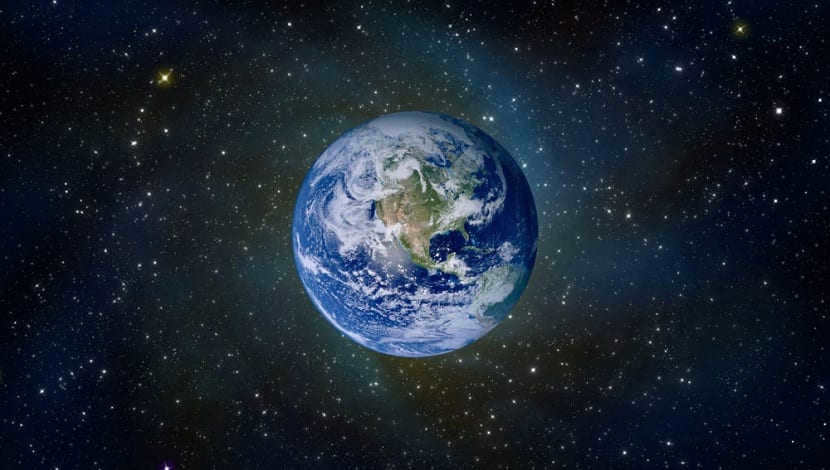
The information presented in this article adheres to our editorial ethics guidelines. If you notice any inaccuracies, please click here to report them.
Full article path: Network Meteorology “Meteorology” Earth’s Geological Layers
2 comments, feel free to share your thoughts
Share your thoughts Feel free to cancel your reply
Alison Tatiana Parra James expressed
Fernando commented
The D¨ layer (also known as the “double simple D layer”) does not possess a DEEPNESS of 200 km/s, but instead it has an estimated THICKness of about 200 km. There is some information available, however, it is quite general and may confuse readers due to the lack of specificity. PLEASE DO NOT USE THIS ARTICLE AS A REFERENCE FOR ANY WORK.
The lithosphere refers to the Earth’s solid outer shell, with a thickness ranging from 50 to 200 km. The upper portion of this shell corresponds to the Earth’s crust.
Plates
The lithosphere is commonly perceived as a singular entity. However, this perception is misleading. In reality, it consists of distinct segments known as lithospheric plates. These plates are separated from one another by fractures and appear to be floating on the mantle’s surface, specifically on its plastic layer. This arrangement facilitates the movement of the plates, which occurs at an incredibly slow pace. On average, the plates shift merely a few centimeters annually. Although this may appear insignificant, over the course of our planet’s existence spanning millennia, the plates have traversed distances measuring in kilometers.
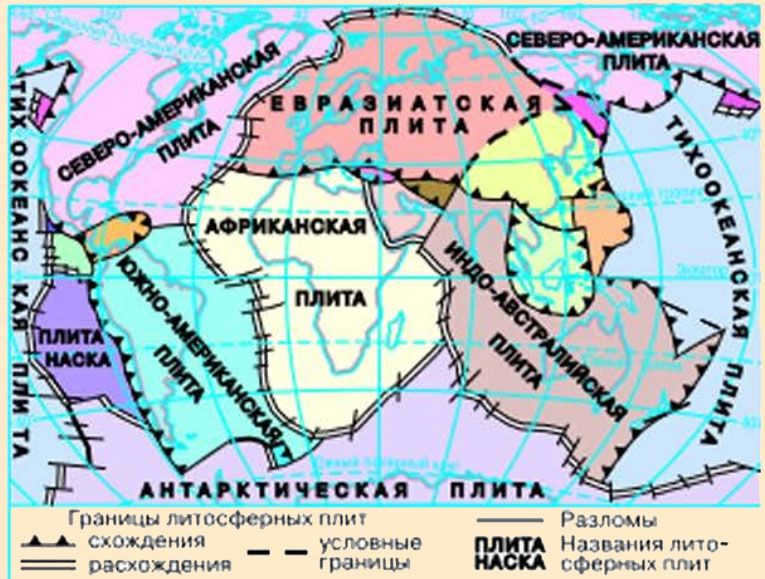
- The Pacific Ocean
- South American Plate
- North American Plate
- African Plate
- Eurasian Plate
- Indo-Australian Plate
- Antarctic Plate
The tectonic plates fold and collide (this is the process that creates mountains) and collide with each other (this is how earthquakes and volcanic eruptions occur).
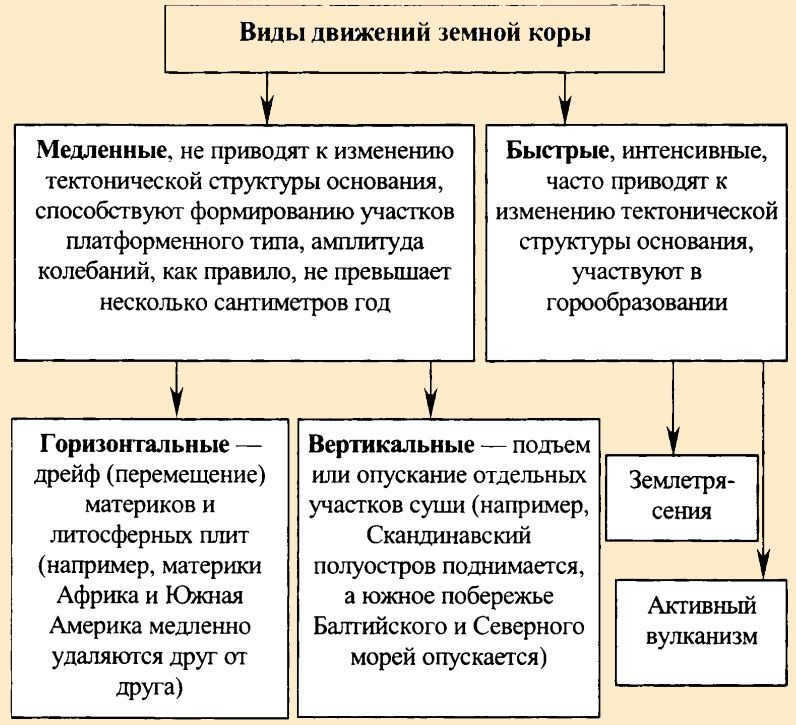
Internal composition
Interestingly, we have significantly less knowledge about the internal composition of the Earth compared to some mysteries of outer space. Generally, we have a good understanding of the Earth’s crust, which is made up of numerous minerals and rocks, but our knowledge about the inner layers is limited.
The planet is divided into three main layers:
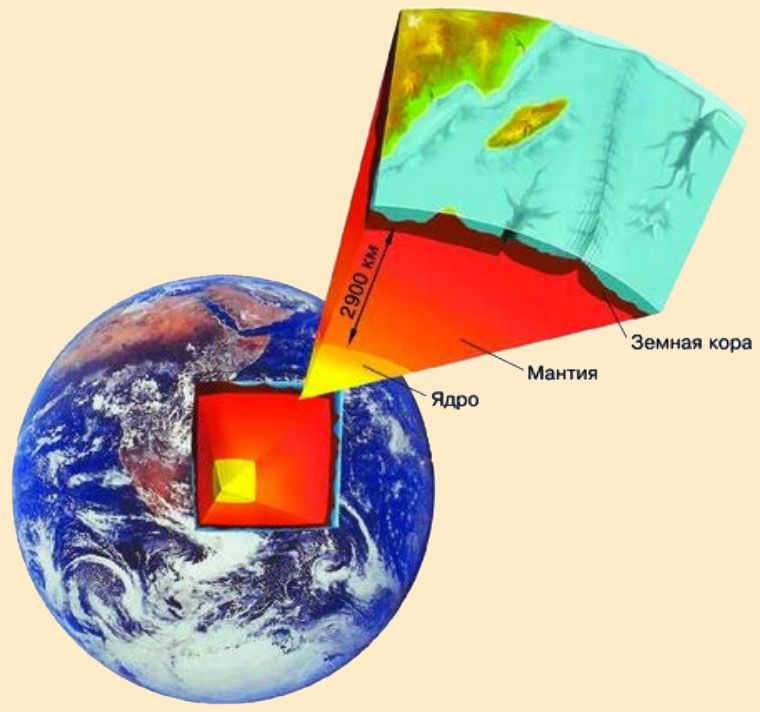

- Earth’s crust. It is the thinnest layer of the Earth’s structure.
- The mantle. It surrounds the core and occupies 83% of the Earth’s volume. The temperatures in the mantle can reach up to 2000 degrees Celsius. Scientists have divided the mantle into two additional layers: the upper mantle, which extends to a depth of 900 km, and the lower mantle, which extends to a depth of 2900 km. The mantle is composed of magma, which erupts from volcanoes.
- The core (outer and inner). The temperature in the core ranges from 2000 to 6000 degrees Celsius. The Earth’s core has a radius of 3,470 kilometers and contains a large amount of iron. The division of the core into inner and outer parts is purely theoretical. Scientists believe that the outer part is molten, while the inner part is solid.
By examining a map (such as an atlas or globe), it becomes evident that land and water form immense masses: continents for land and oceans for water. This arrangement is not accidental, but rather a result of the unique composition of the Earth’s crust.
An apple serves as an excellent visual representation of the Earth’s structure and the relative sizes of its layers. The core of the apple corresponds to the Earth’s core, the pulp represents the mantle, and the peel symbolizes the Earth’s crust. These proportions are roughly analogous to those of the Earth.
The Crust of the Earth
The crust of the Earth is situated on top of the lithosphere. It constitutes a thin layer, with a maximum thickness of 70 km. Notwithstanding this, the composition and structure of the Earth’s crust are exceedingly intricate and varied. The Earth’s crust is heterogeneous in terms of both its structure and content. The particulars of the crust’s structure, its thickness, and composition are heavily reliant on the type of landmass it pertains to. The Earth’s crust can be categorized into two main classes: continental and oceanic.
The Earth’s crust is examined through several methods:
- by analyzing rocks exposed on steep slopes
- through drilling deep into the ground
- by studying seismic waves
- using observations from space
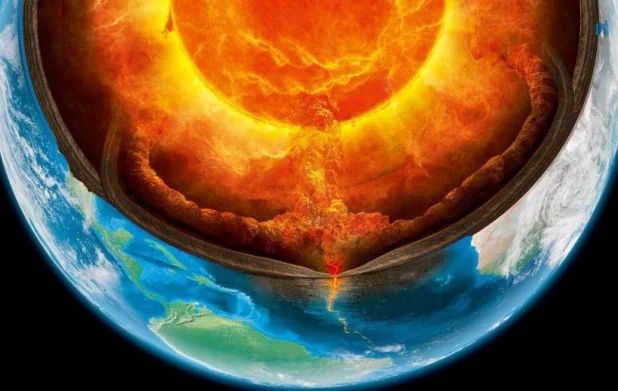
The Earth is a unique planet that stands out from others due to the presence of life. However, scientists have always been fascinated by its structure. As you may already know, the Earth is composed of several layers. In our 6th grade lesson, we will delve into the first layer – the lithosphere. We will explore the internal structure of the planet and the Earth’s crust, as well as the various landforms and types of rocks that exist. Additionally, we will learn about how landforms are identified and labeled on plans and maps.
The structure and composition of the Earth’s crust
Jules Verne, the renowned French author, penned numerous works of science fiction in his time, which have now become a reality in the modern world. For instance, his novels “20,000 Leagues Under the Sea” and “From the Earth to the Moon” have partially come to life. However, not all of Verne’s ideas have materialized. It has been more than a century since the publication of his book “Journey to the Center of the Earth,” yet embarking on such a journey remains a mere fantasy in the present day.
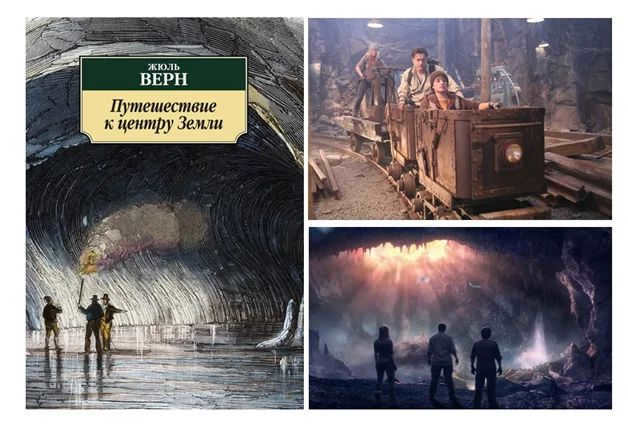
The Earth’s inner workings remain largely unknown to us. To put things into perspective, the deepest borehole ever drilled is only about 12 kilometers deep, which is roughly a thousand times smaller than the Earth’s radius. This depth is minuscule in comparison to the immense size of our planet.
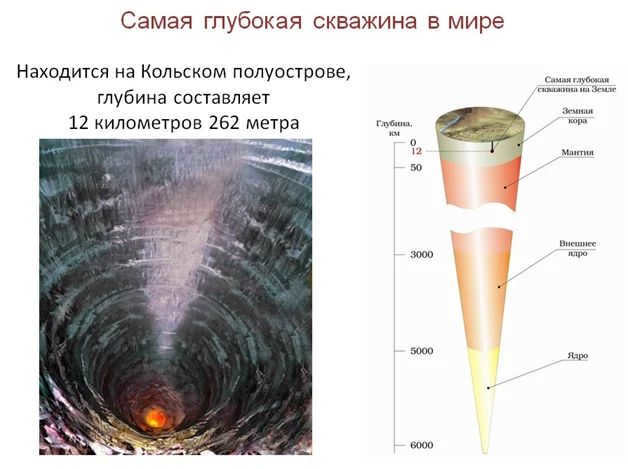
What is the composition of the Earth’s rocks and in what state are they found, solid or liquid?
Scientists can only speculate. However, they have developed a certain theory about the internal structure of our planet using geophysical methods. The most reliable information has been obtained through seismic methods. This involves creating an explosion on the Earth’s surface and recording the resulting vibrations. Different rocks transmit seismic waves at different speeds. For instance, sedimentary rocks transmit waves at a speed of approximately 3 kilometers per second, while granite transmits waves at a speed of about 5 kilometers per second.
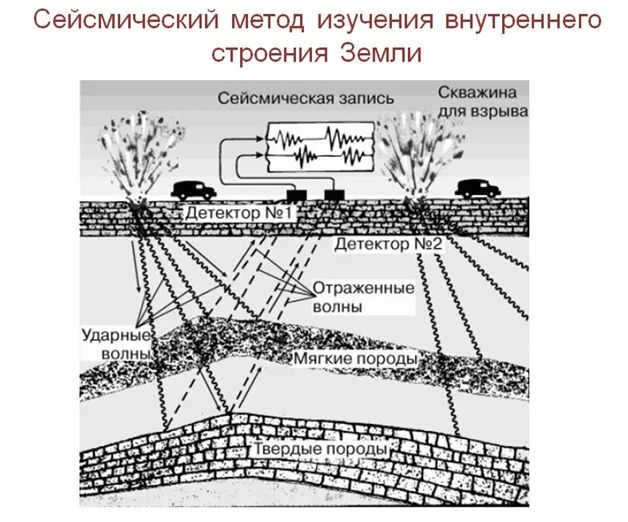
What do we know about the internal composition of the Earth?
Scientists believe that the Earth can be divided into distinct layers, namely the crust, mantle, and core.
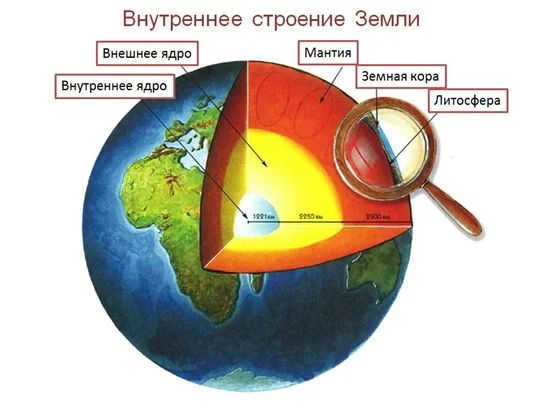
The lithosphere is located on the surface of the planet. The initial section of it is referred to as the Earth’s crust. It serves as the foundation for our daily activities, with cities, towns, and rivers all existing upon it.
A distinctive feature of the Earth’s crust is its relatively shallow depth of approximately 1200 km. Nevertheless, its thickness is not uniform throughout. Under continents, the Earth’s crust is more substantial and, therefore, exhibits a complex structure. Underneath the oceans, it is comparatively thinner.
The Earth’s crust is composed of rocks originating from different sources. Some rocks are more solid, while others are more fragmented, yet all are considered integral components of the Earth’s crust.
The figure illustrates the chemical composition of the Earth’s crust.
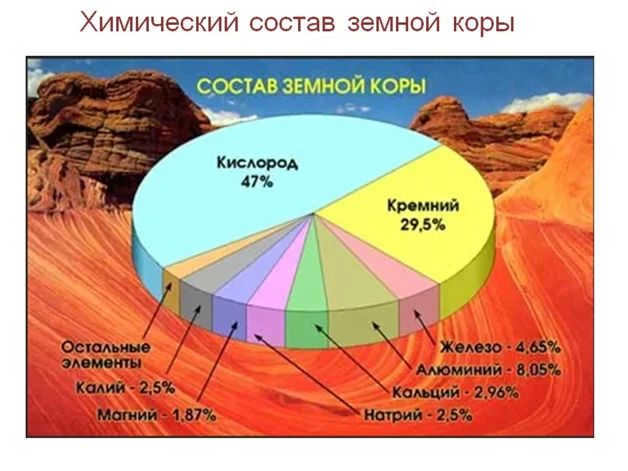
Although it may seem that the surface of the Earth is motionless, the Earth’s crust is constantly moving. These movements are very slow and often go unnoticed by us.
In order to study the internal structure of the Earth’s crust, scientists drill various boreholes into it. Through these boreholes, scientists have been able to determine the composition and structure of the Earth’s crust.
The upper part of the Earth’s crust transitions into the mantle, which extends to a depth of almost 3000 kilometers. It is believed that the Earth’s mantle is both solid and plastic, and it is also extremely hot. The temperature increases as one goes deeper into the mantle.
Different Types of Rocks
The Earth’s crust is composed of a wide variety of rocks and the minerals that constitute them.
Minerals are diverse substances, both in terms of their composition and physical characteristics. They can vary in color, transparency, hardness, and other properties. Many minerals are also considered rare, such as platinum, diamonds, and silver.
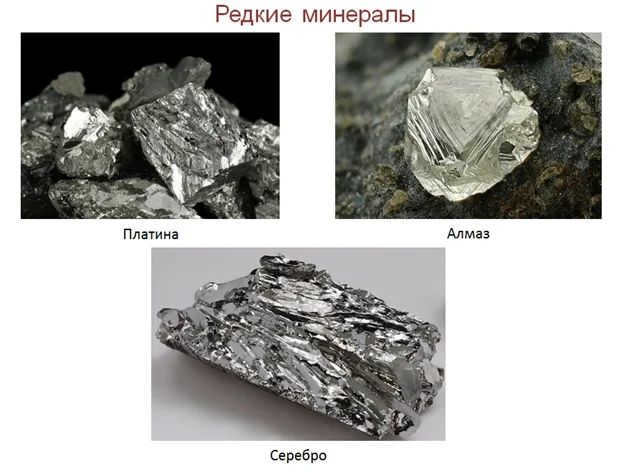
In nature, it is always possible to observe minerals that constitute rocks. The figure illustrates the most prevalent ones.
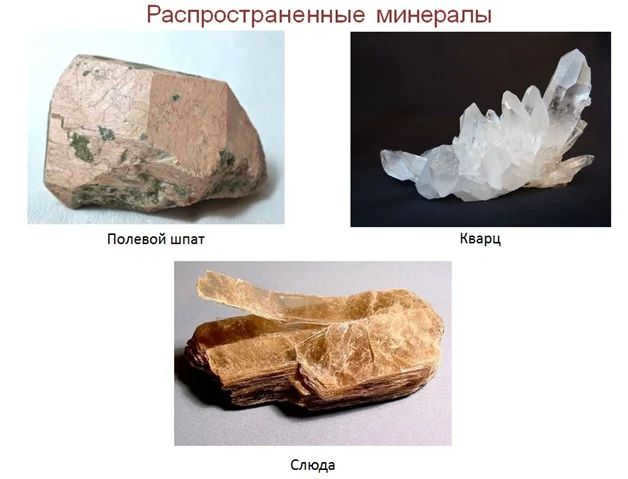
The densities of minerals in rocks vary depending on their origin and the conditions in which they were formed. Rocks can be classified into three main types: magmatic, sedimentary, and metamorphic.
- Magmatic rocks are formed when molten material from the mantle or magma rises to the surface and cools. If the magma solidifies slowly under high-pressure conditions, it forms rocks with a granular crystalline structure, such as granite. On the other hand, if the magma quickly solidifies on the Earth’s crust, it forms rocks with fine-grained or porous structures. Examples of such igneous rocks include basalt, volcanic tuff, pumice, and others.
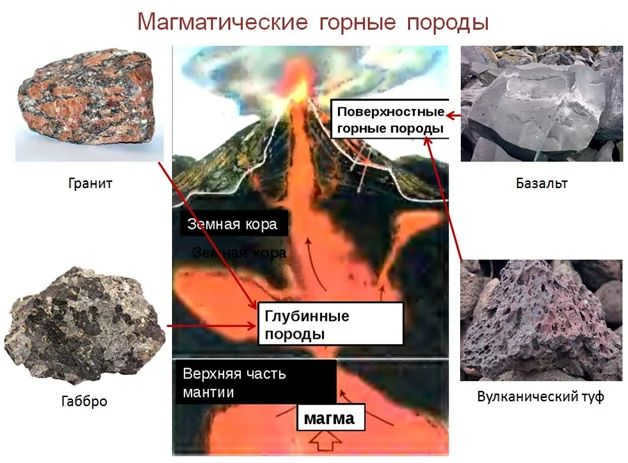
- Different processes lead to the formation of sedimentary rocks on the Earth’s surface. When sedimentary rocks are formed as a result of the activities of living organisms, they are considered to be of organic origin.
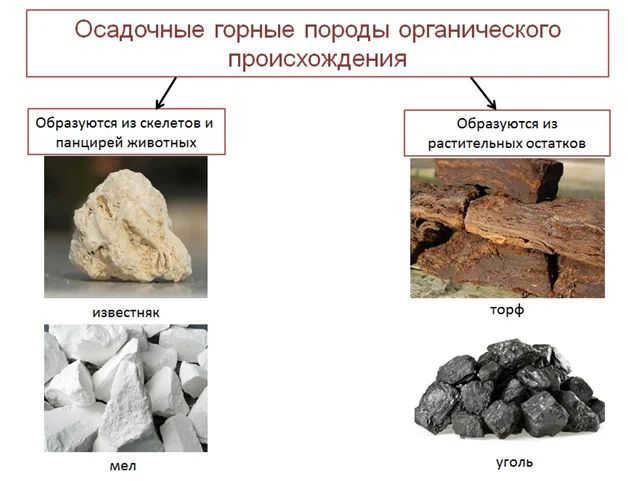
Due to the influence of external elements on the landscape, clastic rocks are created. The fragments vary in size. When these fragments combine, they form compact rocks. Examples of these sedimentary rocks include sandstone, clay, loam, crushed stone, and more.
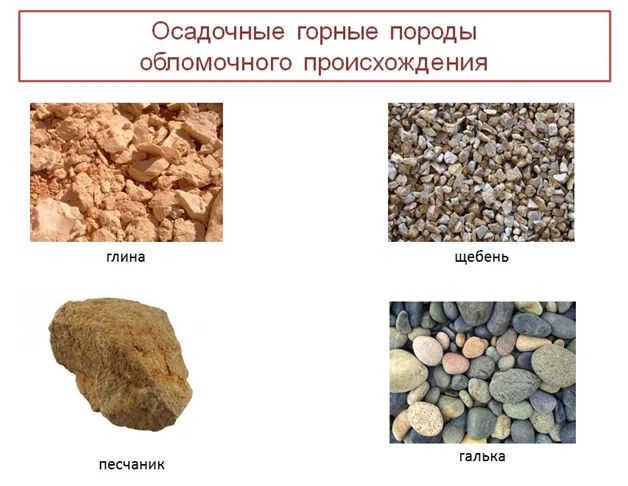
The formation of sedimentary rocks occurs through chemical reactions that occur in water. It is well-known that water has the ability to dissolve numerous substances. When these substances are present in large quantities, they start to accumulate near the bottom. This process leads to the creation of chemical sedimentary rocks like table salt, bauxite, gypsum, and various others.
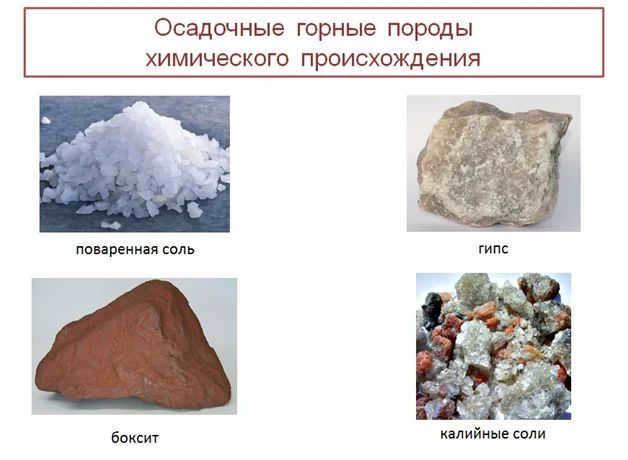
- Metamorphic rocks are formed through the process of metamorphosis, which occurs when other rocks are subjected to high temperatures and pressure in the Earth’s deep layers. This transformative process gives rise to new types of rocks.
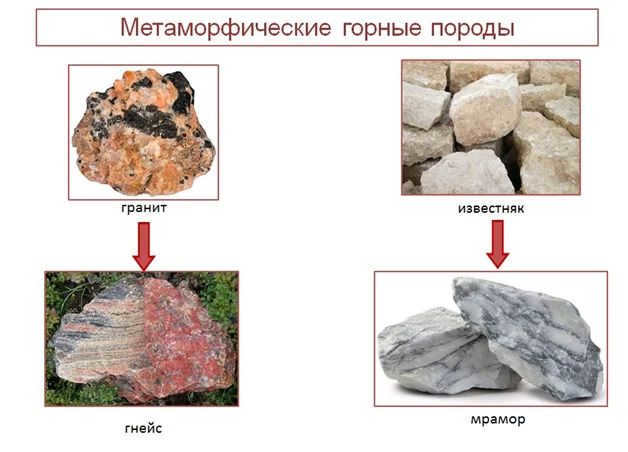
Although the rocks may have different origins, they are all interconnected.
The Structure of the Earth’s Crust and Lithosphere
The Earth’s upper layer is a thin shell made up of diverse rocks. As previously stated, its thickness differs in different locations, resulting in two types of crust: continental and oceanic.
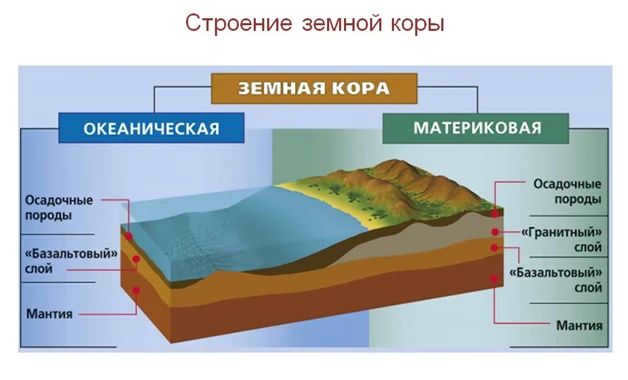
The thickness of the continental crust varies, ranging from approximately 40 km on the plains to about 70 km in mountainous areas. The continental crust is composed of three distinct layers. The uppermost layer consists of sedimentary rocks, while the lower layers are made up of igneous and metamorphic rocks. These lower layers are commonly referred to as the “granite” and “basalt” layers.
On the other hand, the crust beneath the oceans is known as the oceanic crust and is much thinner, measuring only about 7 km in thickness. The oceanic crust is composed of two layers. The upper layer is comprised of loose marine sediments, known as the sedimentary layer, while the lower layer is made up of basalt. One key difference between the oceanic crust and the continental crust is the absence of a granite layer in the oceanic crust.
The mantle, which is connected to the Earth’s crust and forms the lithosphere, is considered to be the crucial internal component. The figure illustrates the composition of the lithosphere.
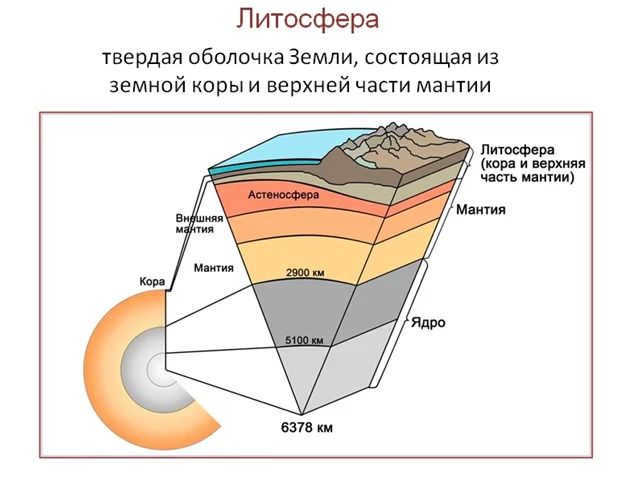
The lithosphere is situated above the mantle and has a sensation of floating on it. Consequently, it has the ability to shift in various directions. The composition of the lithosphere is distinguished by its diversity. It consists of sizeable sections known as lithospheric plates. Let us acquaint ourselves with these plates on the lithospheric plate map.
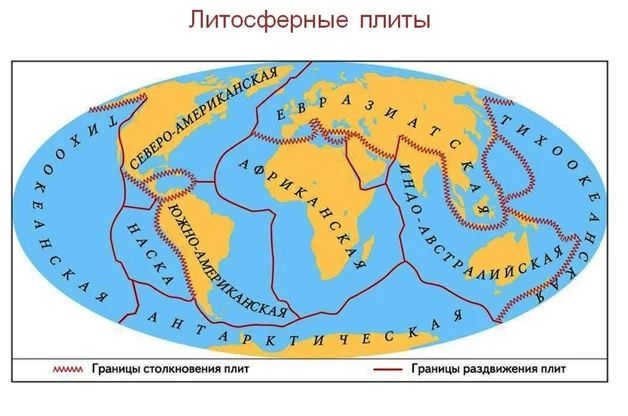
On Earth, there are 7 major lithospheric plates that interact with one another. These plates move across the mantle, creating separation in some regions and collision in others. This process ultimately shapes the Earth’s topography.
Relief and its primary manifestations
Upon closer examination of the Earth’s surface, one can observe its lack of uniformity. Certain areas are flat while others are elevated. This alternation of landforms is commonly referred to as relief. The modern relief of the Earth encompasses all the irregularities found on its surface.
Relief forms are any variations in the Earth’s surface. The main manifestations of relief include continents, oceanic trenches, mountains, and plains. Convex relief forms consist of mountains, ridges, elevations, and hills. Examples of concave relief forms include lowlands, intermountain basins, and ravines, among others.
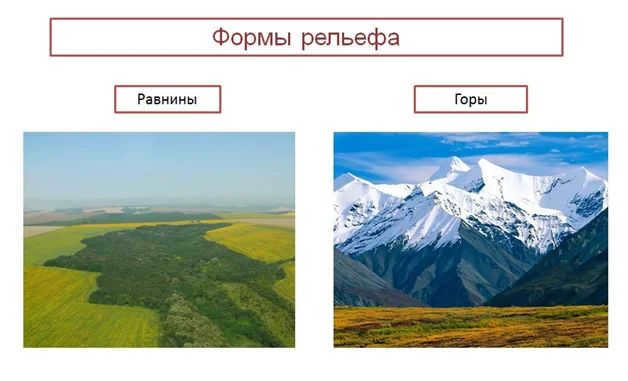
The relief of the Earth is created by various factors. There are both internal and external processes that shape the Earth’s relief. Mountains and plains are examples of relief forms that are formed by internal forces. River valleys, hills, and ravines are examples of smaller parts of the Earth’s relief that are formed by external forces.
Now, let’s take a closer look at one specific type of relief – plains. Plains are large surface areas with minimal changes in elevation and gentle slopes. They vary in terms of their absolute height, and you can see more details in the image below.
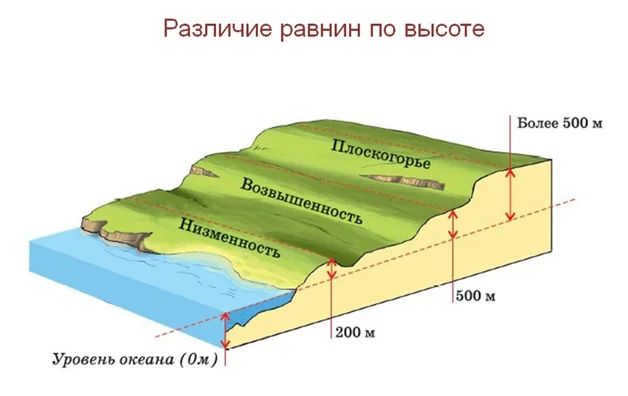
The lowland plains encompass a variety of regions, including the Amazon, Caspian, West Siberian, and others. The Middle Russian Plain, Valdai Plain, and Volga Plain are considered elevated areas. The Middle Siberian, Arabian, and Deccan plateaus are known for their significant size. The East-European Plain, on the other hand, boasts an interesting relief, featuring a mix of elevated and lowland areas.
The appearance of plains can vary greatly. Some may appear flat, while others may be undulating, hilly, or stepped. These differences in appearance are influenced by the origins and structures of the plains.
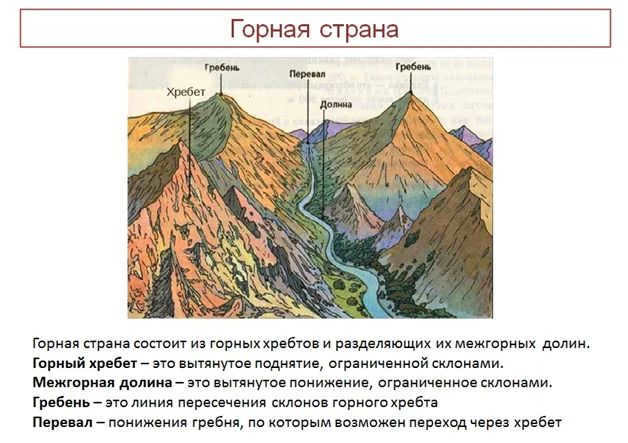
All landforms are categorized as mountains, as they consist of various components.
Mountains vary in their elevation, which in turn affects their overall appearance.
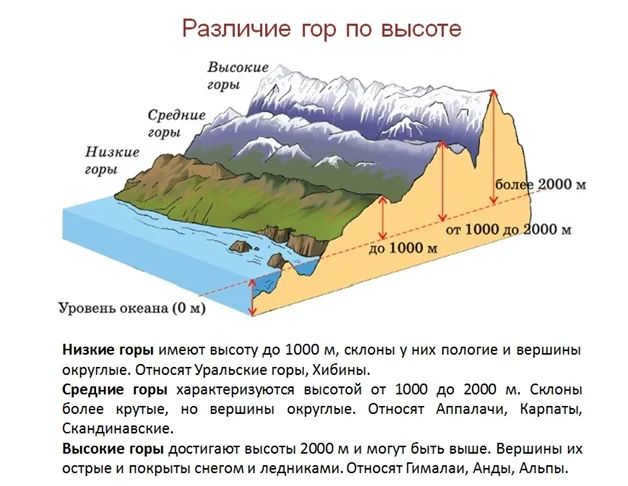
Mountain ranges are shaped by internal forces, but once they are uplifted, the processes of their erosion commence immediately. External forces gradually wear down the slopes and round off the peaks. These processes have ultimately shaped the terrain of the Ural Mountains.
Illustrating topography on maps and plans
Maps can represent the topography of the Earth. To indicate the elevation or depth of the terrain on maps, elevation and depth markers are used. These markers depict the height or depth of the land in relation to the sea level, which is considered to be 0 m. This measurement is known as absolute elevation. Additionally, there is relative elevation, which compares the height of one point of land to another, such as mountain peaks towering over foothills.
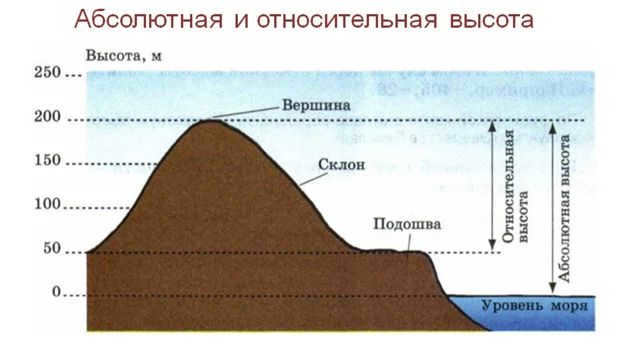
Frequently, you may encounter markers on a map accompanied by numerical values – these symbols represent elevation points.
As an illustration, the precise altitude of Mount Elbrus measures 5642 meters. This figure signifies that Elbrus is situated 5642 meters higher than sea level.
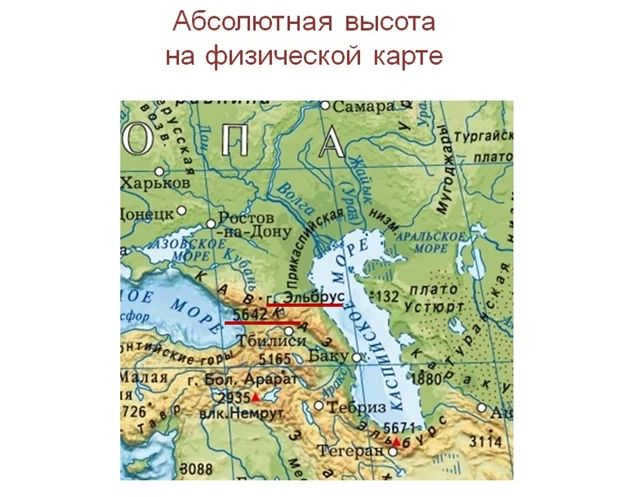
Horizontals are utilized for depicting the surface on the map (they are lines connecting points of the Earth’s surface with identical absolute elevation). On a topographic map, horizontals are accompanied by small lines known as bergstrokes. These bergstrokes are drawn at right angles to the horizontals on the map and indicate the direction of descent on the slope.
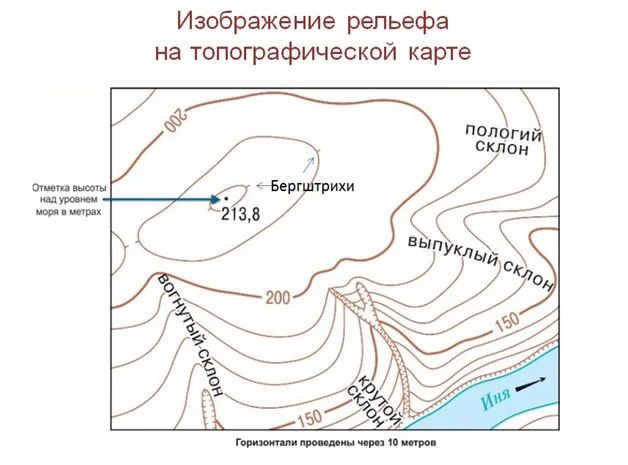
Physical maps use layer-by-layer coloring to depict relief. This technique employs different shades of color to highlight changes in elevation. For instance, land areas with an altitude ranging from 0m to 200m are depicted in green. Heights above 200m are represented using various shades of brown, with darker hues indicating the highest absolute elevations. Similarly, ocean depths are depicted in different shades of blue based on their absolute depths. As a result, the elevation of a specific terrain can be determined by referring to the scale at the bottom of the map.
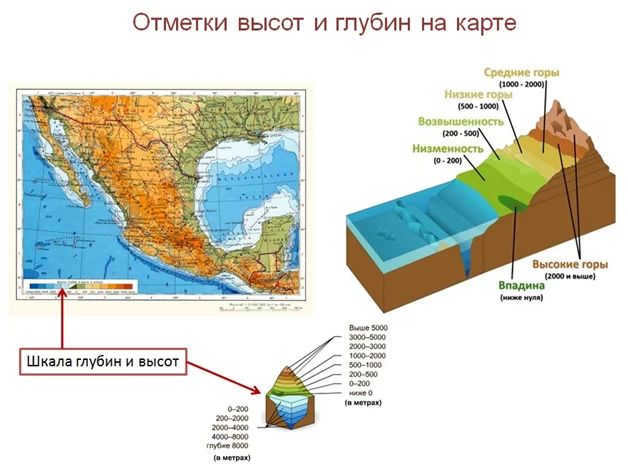
Consequently, a physical representation of the globe can serve the purpose of illustrating the geographical features of a particular region. To achieve this objective, a specific method of describing the terrain is employed.
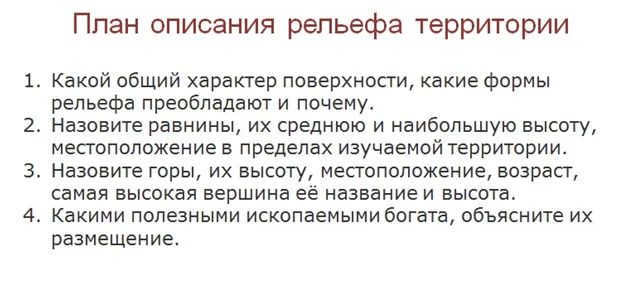
It is feasible to classify not just the topography as a complete, but also its specific shapes portrayed on the map. Below is a strategy for delineating particular landforms.

Therefore, by utilizing maps, we have the ability to provide a comprehensive depiction of the topography of the land on a plan.
Topography of the ocean floor
For centuries, humans have been studying the Earth’s surface, but delving into the depths of the ocean has proven to be quite challenging. As a result, it was not until the latter half of the 20th century that we began to explore and understand the topography of the ocean floor. Through the development of specialized ships and equipment, our understanding of the World Ocean and the relief of its floor has significantly expanded. Consequently, scientists have determined that there are many similarities between the topography of land and the ocean floor.
There are three main forms that can be identified in the topography of the ocean floor: mid-ocean ridges, basins, and transitional zones.
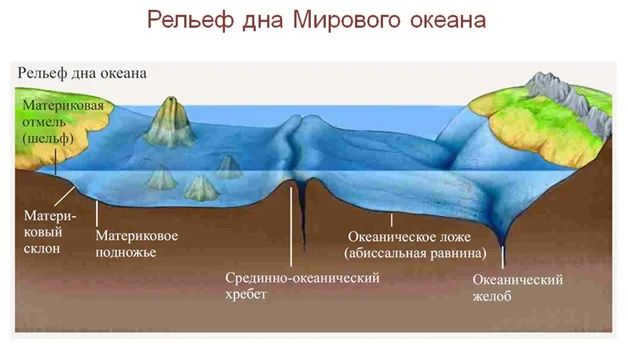
- Mid-ocean ridges, which are situated in the middle of the ocean, are regarded as underwater mountain ranges. This name is derived from their location. These ridges are formed due to the sliding of lithospheric plates. At these fault zones, there is a release of molten lava that solidifies and gives rise to mid-ocean ridges in the oceans.
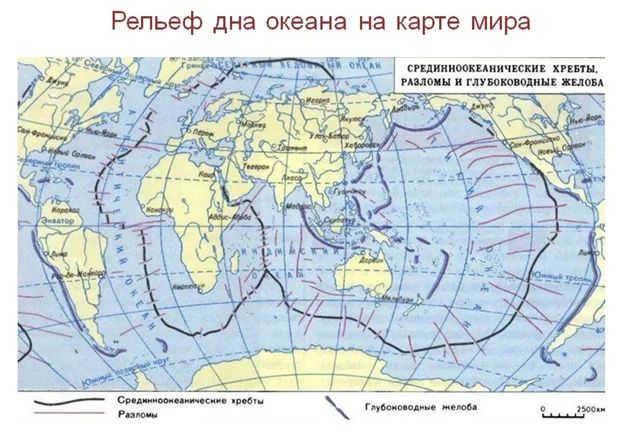
- The seafloor is vast, encompassing a significant portion of the Earth’s oceans. Similar to the terrestrial landscape, there are extensive deep-water plains found here. These plains are covered by a thin layer of sediment. The seafloor also features underwater ridges, with the plains nestled in between. These ridges can be either dormant or active volcanoes, stretching for many kilometers. Occasionally, the peak of a volcano emerges above the water, forming an island. Such geological formations are commonly found in the Pacific Ocean.
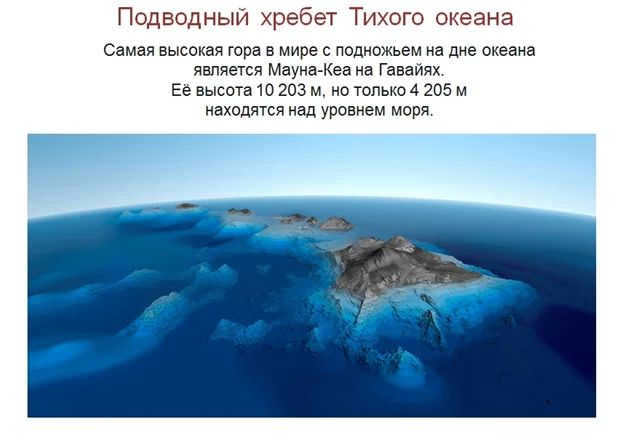
The submerged land area known as the continental shelf spans approximately 200 meters. Situated between the shoal and the bed, the continental slope is a prominent feature characterized by its steep incline. With a cliff depth exceeding 2,900 meters, the continental slope stands as a stark contrast to the Pacific Ocean, which lacks such a transition zone.
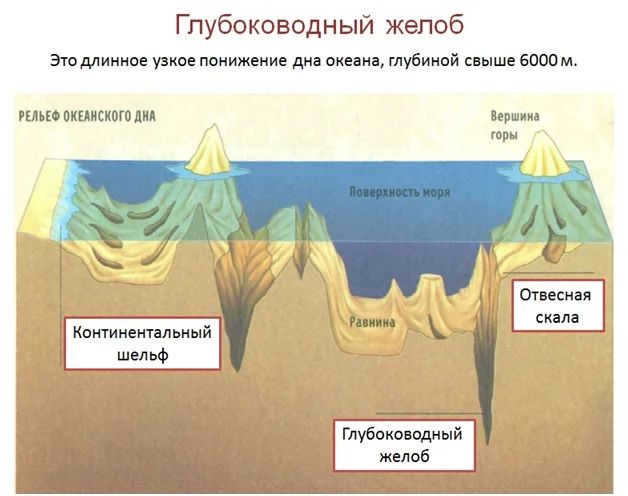
Deep ocean trenches appear as elongated and narrow indentations. These features are created in regions where faults occur due to the collision of tectonic plates.
